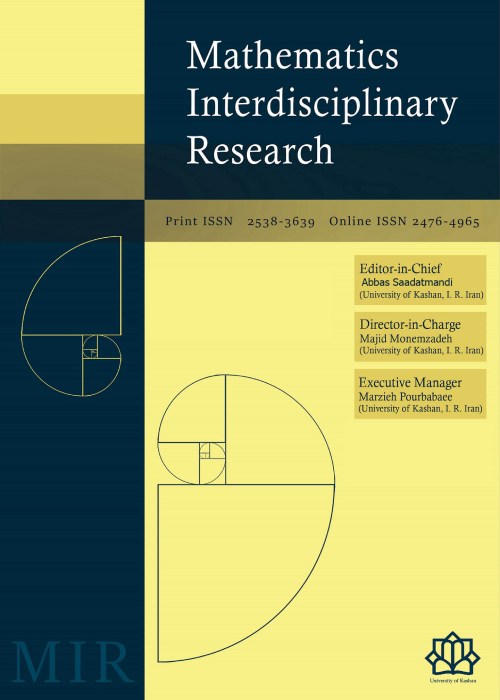فهرست مطالب

Mathematics Interdisciplinary Research
Volume:6 Issue: 2, Spring 2021
- تاریخ انتشار: 1400/11/10
- تعداد عناوین: 6
-
-
Pages 97-105Here, the existence of fixed points for weakly compatible maps is studied. The results are new generalization of the results of [5]. Finally, we study the new common fixed point theorems.Keywords: weakly compatible, cone metric space, common fixed point
-
Pages 107-120The eccentric connectivity coindex has recently been introduced (Hua and Miao, 2019) as the total eccentricity sum of all pairs of non-adjacent vertices in a graph. Considering the total eccentricity product of non-adjacent vertex pairs, we introduce here another invariant of connected graphs called the second Zagreb eccentricity coindex. We study some mathematical properties of the eccentric connectivity coindex and second Zagreb eccentricity coindex. We also determine the extremal values of the second Zagreb eccentricity coindex over some specific families of graphs such as trees, unicyclic graphs, connected graphs, and connected bipartite graphs and describe the extremal graphs. Moreover, we compare the second Zagreb eccentricity coindex with the eccentric connectivity coindex and give directions for further studies.Keywords: Distance in graph, vertex eccentricity, Bound, extremal graphs
-
Pages 121-138This paper proposes a new linear program for finding a relative interior point of a polyhedral set. Based on characterizing the relative interior of a polyhedral set through its polyhedral representing sets, two main contributions are made. First, we complete the existing results in the literature that require the non-negativity of the given polyhedral set. Then, we deal with the general case where this requirement may not be met.Keywords: Polyhedral set, representing set, relative interior point, maximal element, linear optimization
-
Pages 139-149Assume that A is a Grothendieck category and R is the category of all A-representations of a given quiver Q. If Q is left rooted and A has a projective generator, we prove that the big finitistic flat (resp. projective) dimension FFD(A) (resp. FPD(A)) of A is finite if and only if the big finitistic flat (resp. projective) dimension of R is finite. When A is the Grothendieck category of left modules over a unitary ring R, we prove that if FPD(R) < +∞ then any representation of Q of finite flat dimension has finite projective dimension. Moreover, if R is n-perfect then we show that FFD(R) < +∞ if and only if FPD(R) < +∞.Keywords: Quiver, representation of quiver, Grothendieck category, finitistic dimension
-
Pages 151-158
In this paper, we obtain a new conservation law for the Harry Dym equation by using the scaling method. This method is algorithmic and based on variational calculus and linear algebra. In this method, the density of the conservation law is constructed by considering the scaling symmetry of the equation and the associated flux is obtained by the homotopy operator. This density-flux pair gives a conservation law for the equation. A conservation law of rank 7 is constructed for the Harry Dym equation.
Keywords: Harry Dym equation, conversation laws, scaling symmetry, homotopy operator -
Pages 159-170Historically, mathematics and architecture have been associated with one another. Ratios are good example of this interconnection. The origin of ratios can be found in nature, which makes the nature so attractive. As an example, consider the architecture inspired by flowers which seems so harmonic to us. In the same way, the architectural plan of many well-known historical buildings such as mosques and bridges shows a rhythmic balance which according to most experts the reason lies in using the ratios. The golden ratio has been used to analyze the proportions of natural objects as well as building’s harmony. In this paper, after recalling the (mathematical) definition of the golden ratio, its ability to describe the harmony in the nature is discussed. When teaching mathematics in the schools, one may refer to this interconnection to encourage students to feel better with mathematics and deepen their understanding of proportion. At the end, the golden ratio decimals as well as its binary digits has been statistically examined to confirm their behavior as a random number generator.Keywords: Fibonacci sequence, golden ratio, golden rectangular, random number generator


